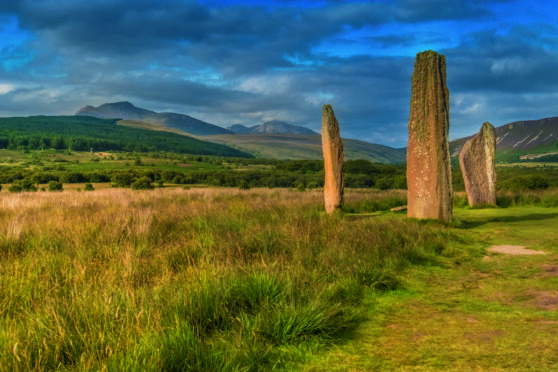
A seemingly normal road in Ayrshire with an unexplained optical illusion has been puzzling people for centuries.
Croy Brae is a bizarre stretch of road which makes your car look as if it is rolling uphill, when it’s actually going down.
The phenomenon was named Electric Brae by the Victorians, who were fascinated by the invention of electricity. Stumped by the anomaly, locals at the time concluded a power source on the nearby Isle of Arran must be pulling vehicles upwards by magnetic force.
Arran is known as “Scotland in miniature” for its dramatic and varied geography. It’s a place of golden beaches, shaded glens and rugged mountains and its highest point, Goat Fell at 874 metres (2,867 feet), makes for a challenging climb.
On the west coast of Arran is the village of Machrie, home to the Machrie Moor stone circles – 11 separate sites, surrounded by the remains of generations of stone huts and more primitive constructions.
People have lived in the area for at least 8,000 years, but work began on the circles in about 3500 BC. They were originally dug as pits, before tall wooden posts were used to erect timber circles. The stone circles appeared in approximately 2000 BC, and it was these ancient structures that modern-day locals believed was causing the phenomenon on the mainland.
Circles One and Two are the most impressive, with one stone topping 5.5m (18ft), though many of their tall red sandstone pillars have now fallen. Circle Five is much lower to the ground, and its 25 granite boulders remain intact in a complex and intriguing double-circle formation.
The circles were possibly used by Neolithic and Bronze Age farmers for religious and ceremonial purposes, with evidence of burials at each site, probably of elite members of the primitive societies.
Folklore says that one circle was named after a mythical giant named Fingal, who once tied his dog up to the stone while he ran an errand.
‘Miniature Scotland’ – Beautiful places to visit around Arran
Keen-eyed visitors have also noticed that the stone circles align with a notch between hills on the horizon, through which the sun rises at the very peak of midsummer.
Could these magnificent standing stones be the magnetic force behind Electric Brae?
Over the years, the sloped brae in Ayrshire has appeared in countless articles and TV programmes, and has attracted a huge number of tourists keen to try out the amazing road for themselves.
In fact, the stretch of road is so popular, that the area displays a sign warning that there will be slow-moving vehicles up ahead as drivers marvel at the effects.
Confused passengers, trying to get to grips with this incredible but eerie spectacle, can be spotted leaning out of vehicles to get a closer look.
Electric Brae begins after a curve in the road of the A719 and features a slope of 1:86 upwards. The landscape on either side, however, creates an optical illusion, making it look as if the road is inclining the opposite way, and giving motorists the feeling that their cars are somehow freewheeling uphill.
Or perhaps the locals were right and the mystical car-pulling force actually originates from the standing stones across the water on the Isle of Arran?

Enjoy the convenience of having The Sunday Post delivered as a digital ePaper straight to your smartphone, tablet or computer.
Subscribe for only £5.49 a month and enjoy all the benefits of the printed paper as a digital replica.
Subscribe